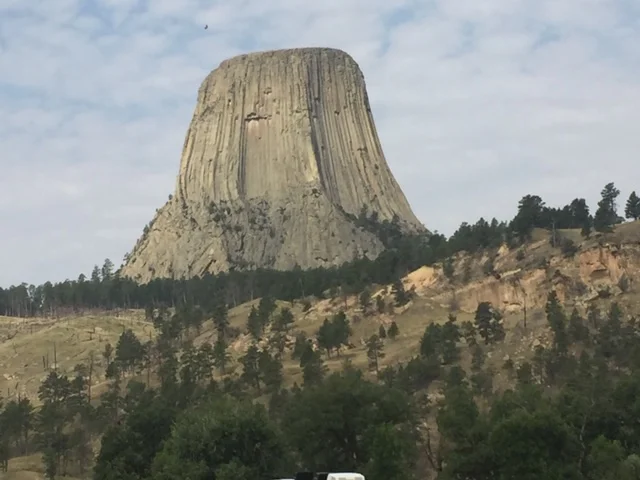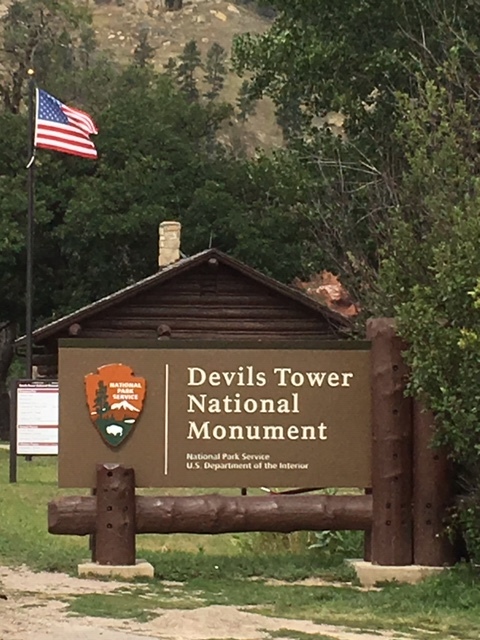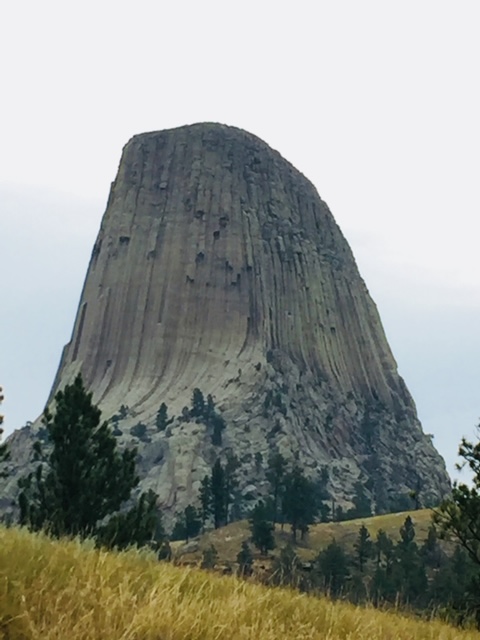Devils Tower National Monument
Wyoming
Saturday, August 18, 2018
Smoky, 82°
"If I croak while I’m doing this, at least I’ll die doing something I wanted to do, and I’ve had a good and long run.” - Dr. Bill Weber, 91 said the climb was tougher than he expected. At points, he wondered if he would make it. (Sept 22, 2018 - Breaks the climbing record as oldest to climb Devils Tower)
Ever since Steven Spielberg’s 1977 mega move, “Close Encounters of the Third Kind,” came out and used Devils Tower as the climactic ending, it has been on my list of places to visit. In my travels, I have seen nothing like it so I really wanted to go and spend time visiting. President Theodore Roosevelt, in 1906, proclaimed the two-square-mile park surrounding the tower as America’s first National Monument.
Just outside the Monument, the Devils Tower KOA is literally just outside the entrance gate sitting along the curving Belle Fourche River.
Campsite view of Devils Tower
There are great views from the campsite of the Tower especially at sunset or sunrise giving a nice contrast against the smoky fire haze in the afternoon and sun rays reflecting off the rock in the morning.
Devils Tower National Monument Sign
Devils Tower National Monument, a unique and striking geologic wonder steeped in Native American legend, is a modern-day national park and climbers' challenge. Devils Tower sits across the state line in northeast Wyoming. The Tower is a solitary, stump-shaped granite formation that looms 1,267 feet above the tree-lined Belle Fourche River Valley, like a skyscraper in the country. Once hidden below the earth’s surface, erosion has stripped away the softer rock layers revealing the Tower. The park is covered with pine forests, woodlands, and grasslands. While visiting the park you are bound to see deer, prairie dogs, and other wildlife. The mountain’s markings are the basis for Native American legend. One legend has it that a giant bear clawed the grooves into the mountainside while chasing several young Indian maidens. Known by several northern plains tribes as Bears Lodge, it is a sacred site of worship for many American Indians.
Legend Bear Claw Marks
The stone pillar is about 1,000 feet in diameter at the bottom and 275 feet at the top and that makes it the premier rock climbing challenge in the Black Hills. Hikers enjoy the Monument’s trails. The 1.25-mile Tower Trail encircles the base. This self-guided hike offers close-up views of the forest and wildlife, not to mention spectacular views of the Tower itself. The Red Beds Trail covers a much wider three-mile loop around the tower. (blackhillsbadlands.com)
The road winding its way to the visitor’s center gives several different views other than the one normally seen in most photos.
A different view of Devils Tower
Parking was slightly limited but there was RV parking on the roadside leading back down the mountain. The rangers gave talks on the theories of the monolith’s formation and the Native legends about the Tower. The talks were very informative and gave insights into this one of a kind Monument within the National Park Service system.
The visitor center is a very small, bare-bones log building that was built by the Civilian Conservation Corps way back in the olden days. Its exhibits are simple and to the point, providing information on the geology and mythology of Devils Tower. The displays gave additional information about the Tower’s history and the rock climbing that takes place on the mountain each year. The only month that rock climbing slows or stop completely is June while the local Native culture has ceremonies and prayers onsite. Along the mile and a half loop trail that circles the tower, prayer flags and offerings are visible, but the ceremonies that incorporate these objects are intentionally less visible.
The most common ritual that takes place at the Tower is prayer offerings. Colorful cloths or bundles are placed near the Tower - commonly seen along the park's trails - and represent a personal connection to the site.
Prayer Flags in trees
They are similar to ceremonial objects from other religions, and may represent a person making an offering, a request, or simply in remembrance of a person or place. As with many religious ceremonies, they are a private to the individual or group. Please do not touch, disturb or remove prayer cloths or other religious artifacts at the park.
It is important to note a key difference between American Indian religions and many other contemporary religions (referred to as "western" or "near eastern" religions): a sense of place dominates the religion of American Indians, as opposed to the sense of time that dominates many western religions. Instead of a focus of chronological events and the order in which they are presented, American Indian religion focuses on a place and the significant events that are connected with that location. Although western religions have their important places, they do not hold the level of sacredness associated with the important places of American Indian religions. (nps.gov)
After walking up the hill, we found ourselves standing at the base of the tower along the trail below a jumble of huge boulders.
Boulder Field at base of Devils Tower
People clambered and scrambled over the rocks up to the very base of the huge monolith. It was fun listening to a choir of different languages and watching as people of all shapes, sizes and ages each found their own ways to experience the Tower.
Rock climbing is big on Devils Tower. About 5,000 climbers come to find their way up Devils Tower every year. Several of us tried to get permits to hang glide off the Tower in the late 70’s but the Park Service would not grant them. We were going to get a helicopter to take us up, drop us and our gear on top to fly down but they were not having anything to do with it. It is great to see the Tower used as a premier rock climbing site as there are over 200 identified routes to the top. Unbelievable as it may seem, one young man scaled the tower in about 16 minutes!
There were several groups of climbers making their way up the sides of Devils Tower. One group was training; with each climber going up several hundred feet then coming back down so the next person could climb up. The other group had at least four climbers who were slowly making their way up the cracks in the vertical rock wall. Two climbers who were just over halfway stopped for lunch before traversing to the side about twenty or thirty feet to another crack as the other two climbers were nearing the top. As we watched, the two made it to the summit and were standing on the edge looking down towards the ground and the other climbers.
Climber on top of Devils Tower
It was amazing to see them working their way up and over the top. I wanted to see them rappel off but figured they would not come down until the other two climbers were also at the top.
On the way back down to leave I went to the restroom where I watched a couple of Japanese teenagers trying to decide if two empty water bottles should go into the Plastic or Aluminum hole in a recycling bin. They finally decide to play it safe and put one bottle in each of the two holes.
I could spend a lot of words describing the stories of Devils Tower, but I won’t. If anyone wants to learn more of the spiritual feeling here, or of its discovery, how it was formed, or how the native name for the place was somehow misinterpreted into Devils Tower, or the tale of the first to climb it, or the stuntman who parachuted to its top only to discover he had no way down, well, if you want to hear those stories, visit the park’s website. (www.nps.gov/deto/index.htm)
Trail View to Boulder Field at Tower Base
Or much better than that, take a road trip to this unique and beautiful place to visit Devils Tower for yourself. You’ll be glad you did, it is time to continue Traveling Life’s Highways to the next amazing place in America.








